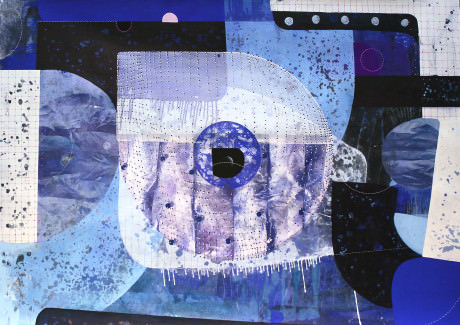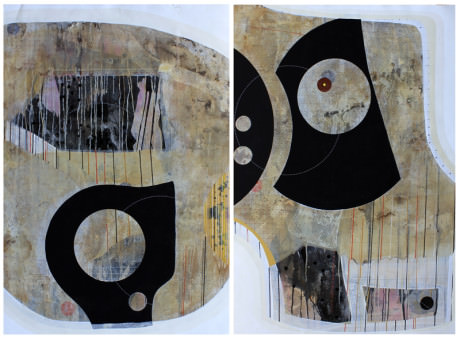Before you make your way to a table at the new Busboys and Poets in Takoma Park, allow yourself generous time to walk around the space and contemplate the worlds inside Joan Belmar’s paintings hanging on the walls. A palette of browns, whites and sepias in granular textures evoke earthy terrain, while velvety black circles suggest opaque nighttime skies. At times, bright colors assert themselves uncompromisingly. Across portions of these mindscapes march topographical stitching lines suggesting boundary demarcations; across other portions meander lines of contour mapping. Belmar’s work is built up layer after layer in a complex dance of opposites—transparent and opaque, textural and smooth, organic and geometric, earthy color and bright reds or blues.

I’m sitting down over coffee with Chilean-born, Takoma Park-based artist Joan Belmar at Busboys and Poets to discuss his work. Entitled Discover the Art of Social and Political Change, the paintings are on exhibit through April 30th.
What is the significance of the title of the show and the bodies of work you show here?
The original title of the show that contained these pieces in 2012 at Charles Krause Reporting Fine Art was Hidden Treasure. The artwork came from two different series: the Americas series, created between 1999 -2006, as an emigrant from Chile and Spain it reflected my first impressions of America; and, the Tierra del Fuego series, created in 2012, inspired by the Anne Chapman book Hain about the ceremonies and the extermination of the indigenous Selknam people by the Chilean and Argentine governments in the early 1900’s.

Do you view your work as overtly political? If not, is it meant primary as an aesthetic experience or is there another take away?
I believe all art is political. The best example for me is Jackson Pollock. His works are abstract and apolitical but they communicated the unrestricted nature of freedom and were used to promote freedom in the United States during the cultural Cold War with Russia. Nevertheless, when I’m working, I don’t think of the work as political. I just follow my instincts, helped by personal experiences, and I do whatever I want. I like to experiment, change, challenge myself. Yes, some of my series could be seen as more or less literal than others. It all depends on the venue I have in mind and my motivation at the moment.
Mapping symbols and circular imagery abound in your work. Why?
I have always been interested in marks, scars, signs, etc., because for me they register evidence of a past. And that became more evident to me during my research of the maps and geographical regions where the Selknam people lived. I love circles because they are present in everything. Think about it, when you look the line between the ocean and the sky it looks straight but we all know that our planet is round.

How important are titles of work to you?
I don’t like to set titles because they can narrow the personal vision of the viewer.I may be completely different from someone who views my work but I believe I can connect with that person through my work about deep, hidden, and universal feelings. That is why my titles are mostly abstract and not explicit, because I don’t want that experience to be narrowed by a title.
Describe briefly your process. Has your background as a graphic designer had an impact on your work?
I work on several pieces at a time and they often become a series. I work on the floor. In the case of my paintings, I choose a supporting base background and then I let the painting freely run, mix, fight and find a destination. Later, I need to find a way to balance and connect it with concepts that I am working at the moment. My three-dimensional work is more disciplined and organized.
My background as a graphic designer gave me the chance to learn to draw and be aware of many art techniques. Also it gave the technical knowledge, which I combine with my intuitive knowledge, to balance intense and chaotic paintings. You need to know these rules in order to know the right way your particular art should break them.
In addition to the paintings in this exhibit you make work that is more 3-D, can you say a few words about these works?
I think of my 3-D work as the voice of the hidden sculptor inside me. I took me many years to develop this technique. I wanted something that would evoke sculptural sensibilities but that was also hard to classify because it didn’t correspond with any specific category. What I came upon was something like sculpture trapped inside a painting frame. I don’t like conventional boxes and I love contradictions. I love the process that involves apparently insignificant, common and translucent objects and how they can be used to create pieces that play with the way we appreciate things. Also, I love how light constantly changes these 3-D pieces and how they also change depending upon the viewer’s angle.

Do you feel the DMV to be a good place to be an artist? In your opinion, what institutions/organizations help artists to exhibit, form a community, and thrive there?
Yes. We live amid a vibrant art scene. But one problem we have is that we don’t have many galleries or other venues that can represent, provide exposure and take artists to a higher level outside DC. In my case, Washington Project for the Arts was crucial to my development as an artist. Also Hillyer Art Space, Transformer, School 33 in Baltimore, and McLean Project for the Arts are great non-profit art organizations where artists can show a serious body of work without thinking about the commercial aspects.
What does the DMV need to help artists thrive?
In general, more education to help people appreciate the visual arts. And, for those beginning to collect art, it is important to emphasize to them that they can collect great art in this area without having to go to New York or abroad.
LINK
Joan Belmar’s website.




